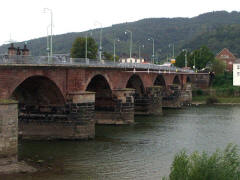Page 1 2 3 4 5 6 7 8 9 10 11 12 13 14 15 16 17 Monday, 10 August. It was another cool, rainy morning when we woke up in Trier, though, like the day before, the rain stopped by mid-morning, the sun came out, and the afternoon was warm. (We'd been to Trier twice before, in 1961 and in 1999.)
We drew lots for departure times again, and this time the yellow group was
last for the tour of Trier, leaving at 9:15.
The ship was just far enough from the old city that we had to go in by bus.
The bus took us along the river past the two treadmill cranes (1413 & 1774)
and the Roman Bridge. Only the bridge pillars date from the Roman construction
(about 150 A.D.). The span that originally rested on them was made of wood.
Our Tour Director then led us to the Archbishop/Elector's Palace and the adjoining Basilica of Constantine. The Basilica was built by emperor Constantine the Great (306-337) about 310 A.D. and served as his throne room where he received visitors. It was later used as the Bishop's residence. Just after 1600 the connecting Palace was built as the new Archbishop's residence. Still later the Basilica was restored to it's original Roman condition, but all the inner decorations were lost in a 1944 air raid. The Basilica is now a Protestant church.
Next we walked to St. Peter's Cathedral, the oldest cathedral in Germany.
Right next to it is the Church of Our Lady (Liebfrauenkirche). The original cathedral, built by
Constantine, was part of a huge complex of four basilicas, covering the space
now occupied by the present Cathedral, the Church of Our Lady, and again as
much space to their front, extending into the present Marktplatz That complex
was destroyed by the Franks when they drove out the the Romans, and again by
the Normans. The present St. Peter's Cathedral was built in the late10th
Century.
From the Cathedral, we walked into Marktplatz, then down Hauptplatz to the Porta Negra (Black Gate). Certainly the Romans never called it that, though, because it was built of yellow sandstone. The dark color only came over many centuries of pollution. The Tour Director pointed out the places where the iron bars that held the stone blocks together had been chiseled out of the gate by people who wanted the iron. Our group then walked a block toward the river to catch the shuttle bus back to the ship, and we were aboard by noon. We had arranged to meet our German friends, the Marenbachs, at 2:00, but we knew they were always early. So we were disappointed when we went to the dinning room at 1:00 and found they were going to call tables randomly for a buffet lunch. We explained the situation to the manager, and he made a point of calling our table first so we could finish in time. We left the dining room at 1:40, and as we passed through the lobby, there were the Marenbachs coming on board.
They had offered to take us to some of my ancestral villages, and we had
accepted with the understanding that we would go only if the weather was
sunny. By this time it was mostly sunny and quite warm. Our first stop was the
village of Grimburg, site of an old castle (1190) from which the authorities
in Trier administered this area. The castle was destroyed about 1690, then
partially rebuilt in 1978, mostly as a tourist attraction.
We then drove on to the Village of Kell am See, just a few miles away. My ancestors moved here from Grimburg around 1730. We found St. Bartholomu's Church (1840) and the site of the house where my great-grandfather had lived. By this time it was after 4:30 and we had to head back to Trier. We had a drink with the Marenbach's at the ship's bar, then said our good-byes.
The reason we had to rush back was that dinner was at 6:15 instead of the
usual 7:00. This was to accommodate the optional "Musical Trier" tour at 8:00.
The bus took us to an small palace where a pianist and violinist
performed "Andre Rieu-type" music for an hour. It was very enjoyable. We
were back on the ship before 10:00. The ship sailed at 11:15 for
Traben-Trarbach.
Copyright © 2000-2023 DarrellPeck.com All rights
reserved. | ||||||||||||||||||||






